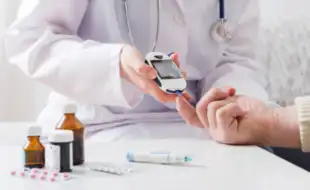
Heatstroke Warning! What To Do If Someone Faints Due To Extreme Heat (Image Credits: iStock)
With temperatures increasing across North India, the risk of heat-related illnesses is higher than ever. According to the latest weather forecast, Delhi, and Rajasthan are grappling with intense heat, and severe heatwave conditions are predicted from April 19 onwards. After a brief reprieve of rain and cool winds, the India Meteorological Department (IMD) has forecast a steady rise in Delhi's temperatures in the coming days. From Wednesday, April 16, the city is expected to experience full-blown heatwave conditions.
As the mercury rises, so does the danger of heat exhaustion and heatstroke — a potentially life-threatening condition that can cause fainting, confusion, or even organ failure. If someone collapses in the heat, don’t panic — what you do in the first few minutes could save their life. Hence, we have listed a step-by-step guide on what you must do.
Step 1: Check for Danger and Call for Help
Before approaching, make sure the area is safe. If the person is unresponsive or unconscious, call emergency services immediately. “Fainting in extreme heat is a red flag. Always assume it could be heatstroke until proven otherwise,” says Dr Sarah Lindstrom, an emergency physician at UCLA Health. Don’t wait to see if the person "comes around." Heatstroke is a medical emergency.
Step 2: Move Them to a Cooler Place
Get the person out of direct sunlight right away. Move them into a shaded area, an air-conditioned space, or somewhere cooler than where they collapsed. Even a few degrees cooler can help reduce the risk of further body temperature elevation. If indoors, crank up fans or air conditioning. Outdoors, use umbrellas, tarps, or your own body to provide shade.
Step 3: Lay Them Down and Elevate the Legs
Gently lay the person flat on their back. Elevate their legs slightly if there’s no sign of head, neck, or back injury — this can help restore blood flow to the brain. If the person is conscious, keep them lying down and calm.
Step 4: Cool Them Down Immediately
Your goal is to lower their core body temperature as quickly as possible — ideally below 102 degrees F (39 degrees C).
Do the following cooling methods while waiting for help:
- Remove excess clothing to expose the skin.
- Apply cool, wet cloths to the neck, armpits, and groin — where blood vessels are close to the surface.
- Fan them while misting them with water to promote evaporative cooling.
- Place ice packs (if available) on the neck, back, or underarms.
“Don't pour ice-cold water directly over them or use ice baths unless you’ve been trained. Sudden cooling can be dangerous,” warns Dr Rebecca Klein, a critical care specialist in New York.
Step 5: Rehydrate — But Only If Conscious
If the person is awake and alert, offer small sips of cool water or electrolyte drinks. Don’t give them anything to drink if they are confused, vomiting, or slipping in and out of consciousness — it could cause choking.
Step 6: Monitor Closely Until Help Arrives
Watch for changes in their breathing, skin colour, or responsiveness. Be prepared to perform CPR if they stop breathing — and follow dispatcher instructions carefully.
“If they start acting confused, slurring speech, or having seizures — that’s classic heatstroke,” says Dr Lindstrom. “Get medical help fast. Time is brain — and organ — in heat emergencies.”
Heatstroke Prevention Tips During Heatwaves
- Stay hydrated — aim for water and electrolyte-rich drinks.
- Avoid peak heat hours (10 am to 4 pm) for outdoor activity.
- Wear loose, light-coloured clothing and a hat.
- Never leave anyone (especially kids or pets) in a parked car — even for a few minutes.
Heat-related fainting is sudden and scary, but with quick thinking and calm action, you can save a person's life.
Get Latest News Live on Times Now along with Breaking News and Top Headlines from Health and around the world.


